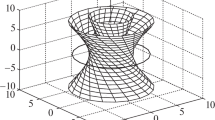Abstract
An extended scale relativity theory, actively developed by one of the authors, incorporates Nottale's scale relativity principle where the Planck scale is the minimum impassible invariant scale in Nature, and the use of polyvector-valued coordinates in C-spaces (Clifford manifolds) where all lengths, areas, volumes⋅ are treated on equal footing. We study the generalization of the ordinary point-particle quantum mechanical oscillator to the p-loop (a closed p-brane) case in C-spaces. Its solution exhibits some novel features: an emergence of two explicit scales delineating the asymptotic regimes (Planck scale region and a smooth region of a quantum point oscillator). In the most interesting Planck scale regime, the solution recovers in an elementary fashion some basic relations of string theory (including string tension quantization and string uncertainty relation). It is shown that the degeneracy of the first collective excited state of the p-loop oscillator yields not only the well-known Bekenstein–Hawking area-entropy linear relation but also the logarithmic corrections therein. In addition we obtain for any number of dimensions the Hawking temperature, the Schwarschild radius, and the inequalities governing the area of a black hole formed in a fusion of two black holes. One of the interesting results is a demonstration that the evaporation of a black hole is limited by the upper bound on its temperature, the Planck temperature.
Similar content being viewed by others
References
A. Sakharov, Sov. Phys. Dok. 12, 1040(1968).
W. G. Unruh, Phys. Rev. Lett. 46, 1351(1981).
G. Chapline, E. Hohlfeld, R. B. Laughlin, and D. Santiago, arXiv: gr-qc/0012094.
G. Chapline, J. Chaos, Solitons and Fractals 10, 311(1999).
G. Chapline, Mod. Phys. Lett. A 7, 1959(1992).
C. Castro, “Hints of a new relativity principle from p-brane quantum mechanics, ” J. Chaos, Solitons and Fractals 11, 1721(2000).
C. Castro, “An elementary derivation of the black-hole area-entropy relation in any dimension, ” arXiv: hep-th/0004018, J. Entropy 3, 12–26 (2001).
C. Castro, “The search for the origins of M theory: Loop quantum mechanics and bulk/boundary duality, ” arXiv: hep-th/9809102; to be published in Information and Entropy Journal.
C. Castro, “Is quantum spacetime infinite dimensional?” J. Chaos, Solitons and Fractals 11, 1663(2000).
C. Castro, “The string uncertainty relations follow from the new relativity theory, ” arXiv: hep-th/0001023; Found. Phys. 30, 1301(2000).
C. Castro and A. Granik, “On M theory, quantum paradoxes and the new relativity, ” arXiv: physics/0002019.
C. Castro and A. Granik, “How a new scale relativity resolves some quantum paradoxes, ” J. Chaos, Solitons, and Fractals 11, 2167(2000).
C. Castro and A. Granik, “Scale relativity in Cantorian ℰ∞ space and average dimensions of the world, ” J. Chaos, Solitons and Fractals 12, 1793(2001).
C. Castro, “The status and programs of the new relativity theory, ” physics/0011040, J. Chaos, Solitons and Fractals 12, 1585(2001).
S. Ansoldi, C. Castro, and E. Spallucci, “String representation of quantum loops, ” Class. Quant. Gravity 16, 1833(1999); arXiv: hep-th/9809182.
A. Aurilia, S. Ansoldi, and E. Spallucci, J. Chaos, Solitons and Fractals 10, 197(1999).
G. Baker, Phys. Rev. 109, 2198(1958).
M. Vasiliev, “Higher spin gauge theories: Star-product and AdS space, ” arXiv: hep-th/9910096.
J. Moyal, Proc. Camb. Phil. Soc. 45, 99(1949).
A. Nesterov and Lev Sabinin, “Non-associative geometry and discrete structure of spacetime, ” arXiv: hep-th/0003238.
B. Fauser, “Clifford Hopf algebra for two-dimensional space, ” arXiv: math.QA/0011263.
Z. Oziwiecz, Czech J. Phys. 47, 1267(1997).
O. Dayi, “q-deformed star products and Moyal brackets, ” arXiv: q-alg/9609023.
M. S. El Naschie, J. Chaos, Solitons and Fractals 10, 567(1999).
M. Pitkannen, “Topological geometrydynamics: TGD, mathematical ideas, ” arXiv: hep-th/9506097 (available at http://www.blues.helsinki.fi/matpitka).V. Vladimorov, I. Volovich, and E. Zelenov, p-Adic Numbers in Mathematical Physics (World Scientific, Singapore, 1994).L. Brekke and P. Freund, Phys. Rep. 231, 1–66 (1993).
W. Pezzaglia, “Dimensionally democratic calculus and principles of polydimensional physics, ” arXiv: gr-qc/9912025“Polydimensional supersymmetric principles, ” arXiv: gr-qc/9909071“Polydimensional relativity, a classical generalization of the automorphism invariance principle, ” arXiv: gr-qc/9608052“Dimensionally democratic calculus and principles of polydimensional physics, ” arXiv: gr-qc/9912025“Physical applications of a generalized Clifford calculus, Papapetrou equations and metamorphic curvature, ” arXiv: gr-qc/9710027.M. Pavsic, “Clifford algebra based polydimensional relativity and relativistic dynamics, ” arXiv: hep-th/0011216, Found. Phys. 31, 1185–1209 (2001)M. PavsicThe Landscape of Theoretical Physics: A Global View, From Point Particles to the Brane World and Beyond, in Search of a Unifying Principle (Kluwer Academic, Dordrecht, 2001).
M. Van Dyke, Perturbations Methods in Fluid Mechanics (Academic, New York, 1964).
E. Witten, “Reflections on the fate of spacetime, ” Physics Today 24,April 1996.
C. Castro and M. Pavsic, “Higher derivative gravity and torsion from the geometry of C-spaces, ” Phys. Lett. B 539, 133(2002), arXiv: hep-th/0110079.
M. Li and T. Yoneya, “Short distance space-time structure and black holes, ” J. Chaos, Solitons and Fractals 10, 429(1999).
K. Fujikawa, “Shannon's statistical entropy and the H-theorem in quantum statistical mechanics, ” arXiv: cond-mat/0005496.
P. Majumdar, “Quantum aspects of black hole entropy, ” arXiv: hep-th/0009008.
J. W. Moffat, “Comment on the variation of fundamental constants, ” arXiv: hep-th/0208109.
L. Nottale, Int. J. Mod. Phys. A 4, 5047(1989).
C. Castro, “Maximal-acceleration phase space relativity from Clifford algebras, ” arXiv: hep-th/0208138;“Variable fine structure constant from maximal-acceleration phase space relativity, ” arXiv: hep-th/0210061.
C. Castro, “Noncommutative quantum mechanics and geometry from the quantization in C-spaces, ” arXiv: hepth/0206181.
Author information
Authors and Affiliations
Rights and permissions
About this article
Cite this article
Castro, C., Granik, A. Extended Scale Relativity, p-Loop Harmonic Oscillator, and Logarithmic Corrections to the Black Hole Entropy. Foundations of Physics 33, 445–466 (2003). https://doi.org/10.1023/A:1023763615328
Issue Date:
DOI: https://doi.org/10.1023/A:1023763615328



